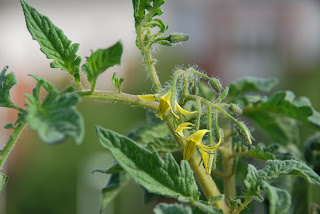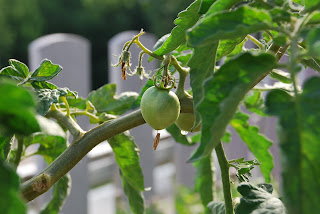Welcome weekend is off to a swinging start (or a rainy, cold start, depending on how you look at it).
The plants and I are hopeful that this cold spell won't last for too long - i'm sure not ready to be done with summer and neither are the tomatoes and squash!
Here is an update on the tomatoes:
Most of the plants have both flowers and tiny tomatoes on them. In case you didn't know, tomato plants are easy to pollinate. Flies, bees, beetles and even wind can move pollen from one tiny yellow flower to another or within a flower. In the case of greenhouse tomatoes where none of those factors may be present, humans can hand-pollinate using a soft, small paint brush or simply apply a vibration like that of an insect's wings.
Two of our six heirloom tomato plants on the Brooks Student Center patio

New flowers, ready to be pollinated ( pictured below)! Unlike many flowers, tomato flowers have both the male (stamen) and female (pistil) parts of the flower closely held together instead of standing up separately of one another. The anthers, which create the pollen, have fused in a cone over the pistil, part of which will become the fruit. Therefore just a little vibration or shaking will get the anthers to release their pollen and it falls down in the cone onto the stigma, moves down through the style and into the ovary. Voila! Fertilization! Have more questions? Go here.

These tomato flowers (below) have been fertilized and their anther cone has started to shrivel up, as its job is now done. The plant stops sending nutrients to the flowers once they are fertilized and starts redirecting nutrients to the new baby tomatoes.

A tiny green fruit will appear inside the ring of outer petals and grow into a tomato. The fertilized flower will dry up and may never get dislodged from the fruit as the tomato grows, as in the photograph below.

Some flowers may never be fully pollinated, others might succumb to disease or pests, while others may be aborted by the plant if conditions are not ideal (aka too wet, too dry, too few nutrients). A flower might be fertilized but never create a mature fruit due to the same circumstances. Consistent temperatures and maximum sun exposure should keep anyone's tomato plants happy enough to bear plenty of fruit.
Our tomatoes have a way to go before they are ready to eat. How are yours doing?
Grow on,
your Tomato Teacher
2 comments:
It's so nice to know that the food I am eating here is home grown! If this is mentioned in the blog, please excuse me, but who takes care of these beautiful gardens?
Renee - Thanks for reading! My name is Tyler (of the female variety) and I'm an employee of Dining Services. I have been tending the gardens since last spring and I'd encourage you to go out on the patio and visit them in person if you are on the Gorham campus. I am also currently starting a food scrap collection program for on-campus composting so i'll be next to the compost bin in the Dining room teaching people what can and cannot go into the compost. I'm sure you'll see me sooner or later.
Best,
Tyler (aka the Garden Guru)
Post a Comment